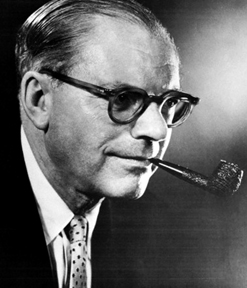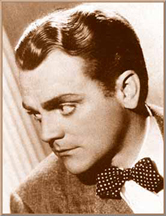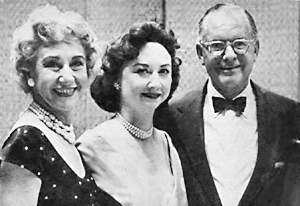The great Henry Fonda was born 108 years ago today. If we were to try to post even a sampling of the great work he did, we would be here all day, so instead, we decided to share with you his appearance on perhaps our favorite television show ever.
Tag: What’s My LIne
Recollections of Cerfdom
 Here at Cladrite Radio, our focus is primarily on the first five decades of the twentieth century, but we do from time to time dip our toes into the 1950s (and even the ’60s, occasionally).
Here at Cladrite Radio, our focus is primarily on the first five decades of the twentieth century, but we do from time to time dip our toes into the 1950s (and even the ’60s, occasionally).
We can think of no better excuse to bend our “rules” than the chances to share this audio interview with publisher, author and What’s My Line? panel mainstay Bennett Cerf, recorded in January 1968, just months after What’s My Line? came to an end.
When the Game Show Network was airing What’s My Line in the wee hours of the morning on a daily basis, we watched the show religiously, thanks to the wonders of Tivo. (Thankfully, Ms. Cladrite is also a devoted fan, so much so that we even gave her signed editions of one of Cerf’s joke collections and Arlene Francis‘s 1960 memoir/self-help tome, That Certain Something: The Magic of Charm, one Christmas.)
If you’re a fan of What’s My Line?, you’ll enjoy Cerf’s reminiscences immensely. If you don’t know the show, you’ll find plenty of episodes on YouTube. But we warn you—it’s habit-forming.
The audio interview shared below is in three parts, totaling around 25 minutes; you’ll want to listen to all three.
Happy birthday to a hardy performer
 Today marks the 92nd birthday of Joe Yule Jr., whom most of us know better as Mickey Rooney. He made his stage debut at the age of 15 months and is still working today, which means his career spans ten decades. That’s an accomplishment that will likely never be matched.
Today marks the 92nd birthday of Joe Yule Jr., whom most of us know better as Mickey Rooney. He made his stage debut at the age of 15 months and is still working today, which means his career spans ten decades. That’s an accomplishment that will likely never be matched.
We have a soft spot for the Andy Hardy movies he made for MGM, corny as they are, but we thought we’d mark Rooney’s birthday by sharing two less familiar clips from his career. The first is an appearance on What’s My Line, in which Mickey’s disguised voice is so annoying, we were praying that the blindfolded panel would quickly guess his identity.
The second clip is from the Mickey McGuire series of comedies from the late 1920s and early ’30s in which Rooney played McGuire himself.
Jimmy from the Block
 After a hectic day, we’re under the wire by less than two hours in wishing James Cagney a happy birthday.
After a hectic day, we’re under the wire by less than two hours in wishing James Cagney a happy birthday.
Had he managed to stick it out a little longer, Cagney, perhaps the quintessential New Yorker, would have been 113 years old today.
Cagney was a delight from the start of his career to the finish, but we especially love his performances in the snappy Warner Brothers programmers of the early 1930s.
Below are three clips, the first two of which are taken from his early days in Hollywood. In the first, Cagney spars with Bette Davis in 1934’s Jimmy the Gent, and in the second, he speaks Yiddish in a scene from Taxi! (1932).
In the final offering, our Jimmy appears as the mystery guest on an episode of What’s My Line? that aired in May 1960.
Number, Please

|
| (r to l) Arlene Francis, Dorothy Kilgallen, Bennett Cerf (Sorry, we couldn’t find Kilgallen’s address or phone number) |
There are three types of vintage publications we can’t resist giving at least a quick browse: retail catalogues, school yearbooks, and telephone directories.
So we were delighted to learn that the good folks at the New York Public Library, bless their hearts, recently posted the 1940 phone books for each of the five boroughs of New York.
If you grew up in NYC or your parents or grandparents did, you’ll have fun tracking them down, but even if, like us, you have no connection to NYC that dates back seventy-plus years or, heck, no family connection whatsoever to the Big Apple, this is still a resource you can enjoy, if only for the joy of perusing the telephone exchanges.
We’ll compose a post one day about our affection for these magical words, but today suffice it to say that telephone numbers that begin not with mere digits but with melodic vocables such as Trafalgar, Whitehall, Butterfield, and Bogardus evoke bygone eras like few other verbal artifacts can.
Then there are the advertisements. We don’t know whether there were yellow pages-style business directories for New York City in those days, but these white pages include plenty of ads: Tyson Sullivan theatrical ticket service, Underwood Typewriters, American Pencil Company, Elfinbein’s Baking Corporation: Bakers of Cakes, Pastries and Pies Since 1918.
Then there’s the celebrity spotting. You might have known that artist Edward Hopper lived and worked at 3 Washington Square—that info’s relatively common knowledge—but did you know his phone number was SPring 7-0949?
We’re tempted to punch in those seven digits; we’re willing to bet the current holder has no idea that America’s greatest painter (in our humble opinion) once took calls at that number.
Then there’s What’s My Line? doyenne Arlene Francis. In 1940, she was a working actress, having appeared in eight Broadway shows and a movie or two. She was married to one Neil Agnew, who worked in the sales department for Paramount Pictures, and they lived at 320 Park Avenue. Their phone number was WIckersham 2-9486. They had separate listings in the phone book, which was probably a good thing, as they were to be divorced just five years later.
Arlene lived just a short stroll away from Bennett Cerf, who would be her fellow What’s My Line? panelist and in 1940 was already the publisher behind Random House. Cerf’s phone number was PLaza 3-0230, and he lived at 20 East 57th Street, just six blocks away from Francis. One wonders if they were yet acquainted in 1940.
